Architecture.
Some notes on different styles and principles for dating.
Ancient bridges are a forgotten area of architecture, particularly from a Scottish perspective, but detailed papers by Inglis are helpful. Gautier (Ref) provides a comprehensive eighteenth-century architectural guide. A modern assessment by Ruddock(Ref) offers many insights into construction along with an inventory of the very oldest structures. Some architectural features help us to date all these old bridges. Thirty-four of them are from the 16th century or earlier. These are listed separately.
Style of earliest bridges.
A Pre-Reformation bridge will probably have a narrower width (less than 12ft) and smaller spans. Broad, heavy piers are more common with huge cutwaters. Refuges often rise above each pier. Little has been written on the shape of masonry arches themselves, yet this may be important; fifteenth-century bridges are more often of pointed arch shape whereas rounded arches suggest sixteenth-century or later. Chamfering of the voussoir edges is common in the oldest bridges, and frequently there is more than one course of voussoir. Hood-moulds are common as are recessed arches. Ribbed soffits are a sixteenth-century feature seldom seen on later bridges. In Scotland, the walls, spandrels and approaches consist of well squared, dressed and coursed rubble stonework or well- weathered ashlar. Many of the earliest bridges have a stepped string course. Parapets are almost always from a later date because they take the brunt of centuries of poor weather. Fig, Jedburgh Bridge.
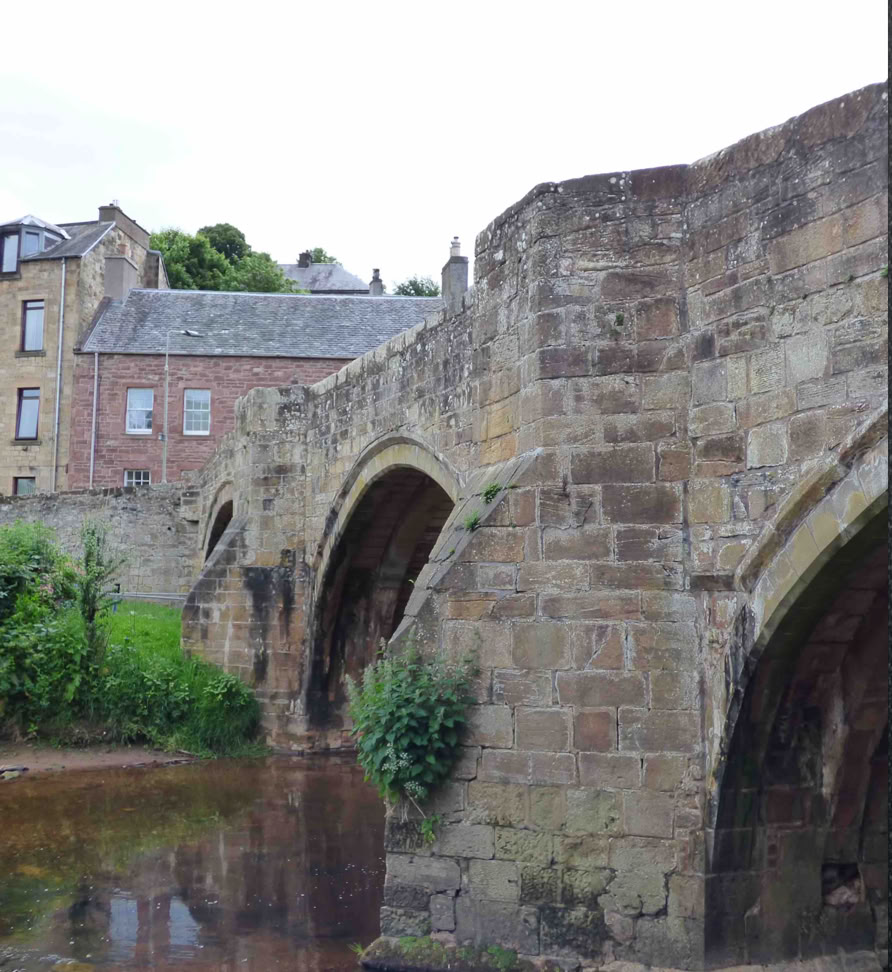
Size of the span.
Inglis (Ref) attributes considerable importance to the size of the span on multi-arch bridges: the arches became larger as time passed and the piers became smaller. He applies this to both England and Scotland. In general, he suggests that bridges built before 1400 had arches with less than 30 feet span, rising to 40 feet by 1450, and 50 feet by 1550. Inexplicably, Inglis appeared to ignore many early medieval, well-built bridges of enormous span in the North of England. If this region is excluded, he appears to be describing a moderately reliable pattern. However, this broad guideline is not very relevant for Scotland since very few bridges have survived from the earlier period, but the principle may contribute to maintenance history; all bridges required extensive repairs every 70 to 100 years and the surviving span-width helps to determine whether the arch (or arches) were retained. This offers a measure of how much substance and style survived the serial repairs.
Shape of the arch (also see Structure section.)
The shape of the arch may be a better feature for dating than the span, and this is especially interesting with respect to pointed Gothic arches. Roman masonry arches were mostly semicircular as were the earliest medieval arches. Architectural evolution away from this rounded Roman and Romanesque style to pointed Gothic happened in the late 12th-century, probably before any vaulted stone bridges were built in Scotland. It follows that our earliest masonry arches were mostly pointed rather than semicircular, and this Gothic shape would have persisted through to the end of the 15th-century (Fig., Balgownie Bridge). Sometime around then the Renaissance style arrived. There was a rejection of Gothic shapes and a return to rounded arches in new palaces and other significant buildings. In Scotland, a pointed arch on a bridge is likely to be a 15th century or earlier design feature whereas semicircular and segmental arches suggest 16th century or later. However, there is a need for caution: a pointed arch may represent a preservation of style through later reconstructions; it may be a copy or an outmoded feature on a 16th century new build, perhaps a function of remoteness from the European Renaissance. In Scotland, there are several examples of Gothic arch remnants existing alongside younger semicircular or segmental replacements. Most of Scotland’s older masonry bridges are rounded, but pointed arches can be seen at Balgownie, Brechin, Tullibody, Dairsie, Haddington (Abbey Bridge), Cramond, Newbattle and Dumfries. Significantly, at Brechin, Dairsie and Dumfries only one pointed arch remains; in these cases, the younger replacements are semi-circular or segmental. However, Stirling Bridge and Guard Bridge both have rounded arches, yet probably a 15th century provenance. This style-change also occurred in England where there are many more ancient bridges to observe (historicbridgesofbritain.com) (Ref). There, T. Robertson’s figures reveal that there are very few remaining 12th-century bridges and that these mostly (75%) have a Romanesque rounded shape. This contrasts with the 13th,14th and 15th centuries in which 65% of arches are pointed. This Gothic shape became less common again in the 16th-century (25%), and very rare after 1600 (in the order of 4%). This analysis, of course, applies only to those structures still existing.
A semicircular arch, as opposed to segmental, also has modest significance. In the North of Scotland, 16th to 18th century arches were generally semicircular until about 1740. Thereafter, segmental was the norm. However, south of Stirling there are many old 16th and 17th century segmental arches, much like in England. There are several caveats with respect to arch shape: occasionally, a deeper segmental arch may be almost semi-circular and it may be sensible to classify it as such; sometimes a segmental arch may be stilted or raised and therefore resemble a semi-circular shape; a broken or sagging semicircular arch can sometimes resemble a pointed one as can be seen at the Bridge of Ayr. A further incidental problem is that photographs tend to distort the shape of an arch, so care is needed. Notes on the structural aspects of these arch shapes can be found here.

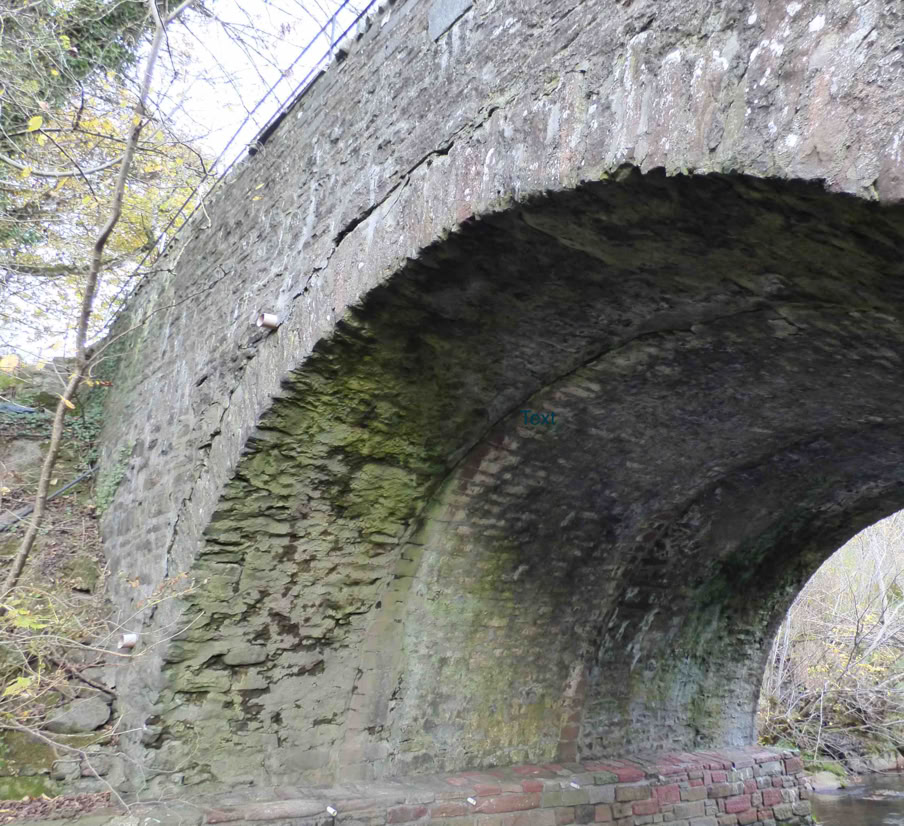
Width.
Width of decking, from parapet to parapet, contributes only a little to the dating of bridges built before 1750. Even in medieval times most masonry bridges were built to accommodate carts although sometimes the approaching roads scarcely met this specification. Seven to nine feet width comfortably permitted single lane cart traffic, and twelve or thirteen feet allowed two lanes. The more urban a bridge, the more often two-lane traffic was considered. This remained the determinant of width throughout the centuries. Even on the 18th century military bridges, 12 ft. wide was a standard. There are exceptions: Bridge of Dee and Dumfries bridges are a little over 14 ft wide; Berwick Bridge (1624) is 17 ft wide, a reflection of its importance, prestige and royal patronage; Haddington Abbey Bridge is 16 ft wide which is quite astonishing and inexplicable. On the other hand, Balgownie Bridge is only 11 ft wide which is fairly narrow for so near a city, and East Linton’s original width of 9ft is quite surprising for a major route. Packhorse bridges, as a group, are an exception and require a separate description. These are rarer in Scotland than south of the border.
After 1760, most bridges were built wider than 14 ft, and at the start of the 19th century a programme of replacement and widening began. Sometimes this was part of a routine repair or rebuild. The original arch was retained and the new arch ‘attached-on’ with the same span and shape. The parallel-widening connection-line can usually be seen on the arch barrel. At Bishop's Bridge in Perthshire (Fig), there are three arches which are clearly visible. Tweed Bridge at Peebles has four. It follows that many bridges have one facade that is visibly different from the other and dates from a later period. In the early 18th century, Thomas Telford specified a 12ft minimum but, in fact, almost all of his bridges were considerably wider than this. In general there remains a rough dating determinant: less than 13 ft. strongly suggests pre-1760; more than 14ft, (original width) suggests post-1760. Smaller Parliamentary Bridges may be the exception.
Ribbed Soffits
Ribbed soffits are a pre-reformation feature seen on twelve of the oldest bridges. Separated rings of the arch were constructed on centering and then slabs were overlaid (Fig: East Linton). The feature is equally distributed occurring on pointed, segmental and semi-circular shapes. Ribbing was an economy: fewer arch rings meant less wooden centering was needed and implied the need for less well-dressed stone. Most of Scotland’s ribbed bridges were built in the first half of the 16th century. There are twelve in all (see Lists), and in the past there were three more at Inverness, Leith and Hawick. However, there are a few later bridges that also have ribbing: Bothwell Bridge, Bridge of Dye (17th century) and Gannochy Bridge (late 18th century).



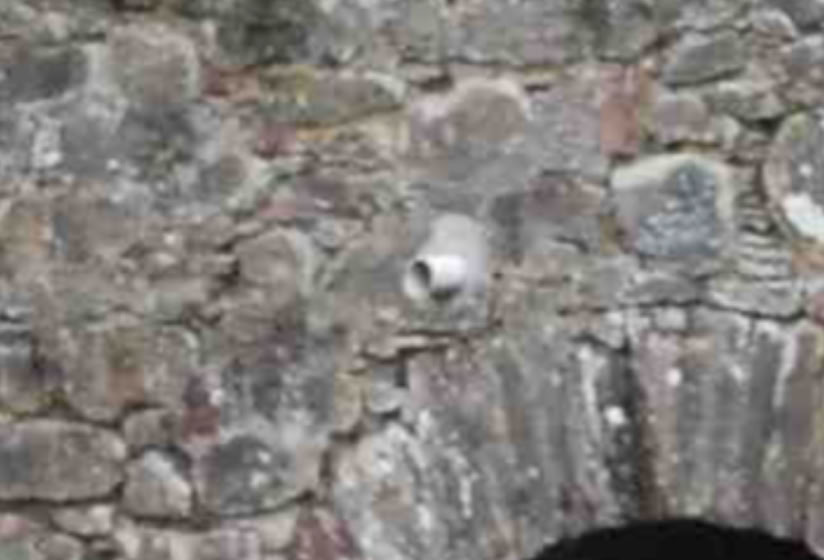
Ashlar and Rubble.
Bridges before 1680 were mostly built in squared, coursed, well dressed, rubble masonry, or in ashlar, usually with irregular stone size (left, Stirling). It is not easy to differentiate very weathered ancient ashlar from coursed, dressed, well-squared rubble, and serial repairs mean that both may exist side by side. Ashlar arches were the rule, often recessed.
In the late 17th century, a marked change took place: much courser rubble masonry was used, particularly for smaller bridges. The best examples are the old packhorse bridges, and drove bridges, most of which were omitted by the Roy survey. This interlude, characterised by cruder masonry, lasted for more than 100 years.
Sometimes random un-coursed rubble was very roughly dressed, if at all, although usually the stones were better squared and dressed. Often one can see a variable degree of sneck-style with discernible levellers and risers. The voussoirs on all these bridges were usually of whinstone and rather better finished than the spandrels. Fully squared dressed snecked masonry became a very common style in 19th century Scotland.

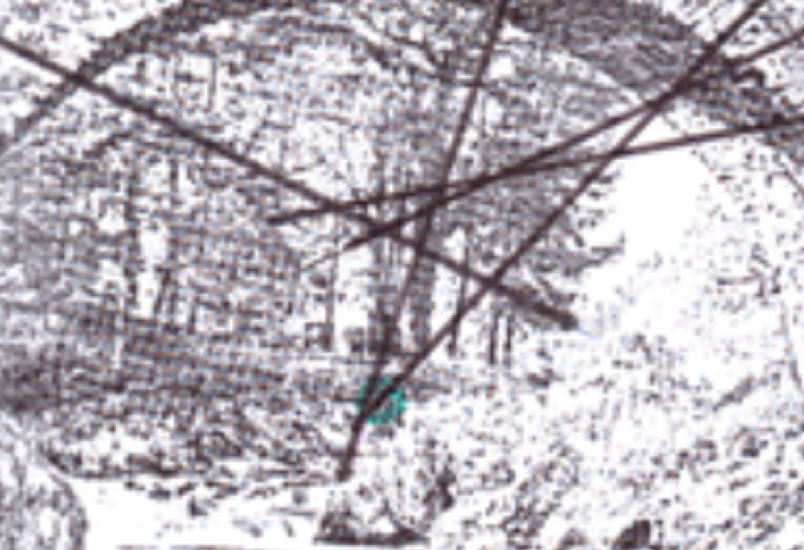
The voussoirs on the earlier rubble bridges had non-radial joints: i.e.,they were not in line with the radius of the circle. Carrbridge (1717), is a good example. With the photo is a limited quality sketch photo of the same bridge in which an attempt has been made to demonstrate this. Each voussoir seems at a completely independent and unrelated angle relative to the central
focus of the arch. This changed, after about 1740, around the time when Caulfield military bridges arrived. Wade’s bridges are mostly older fashioned. Bridge of Dochart , built in 1760, offers a good example of radially aligned voussoirs.
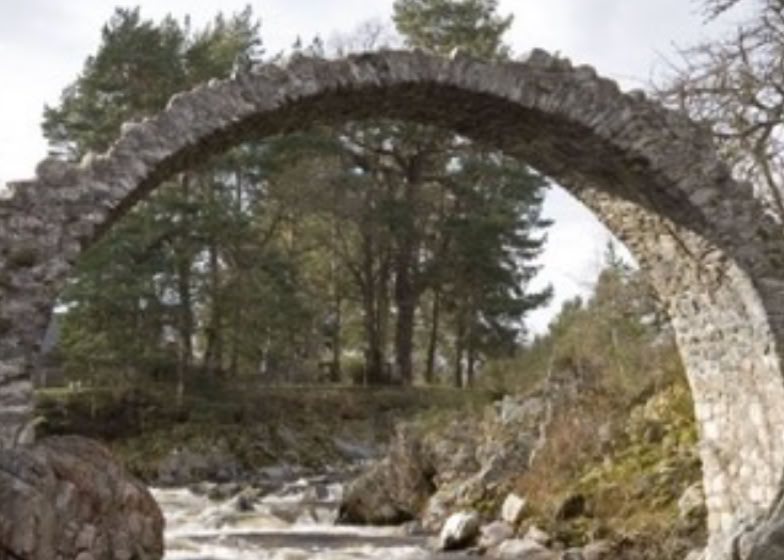
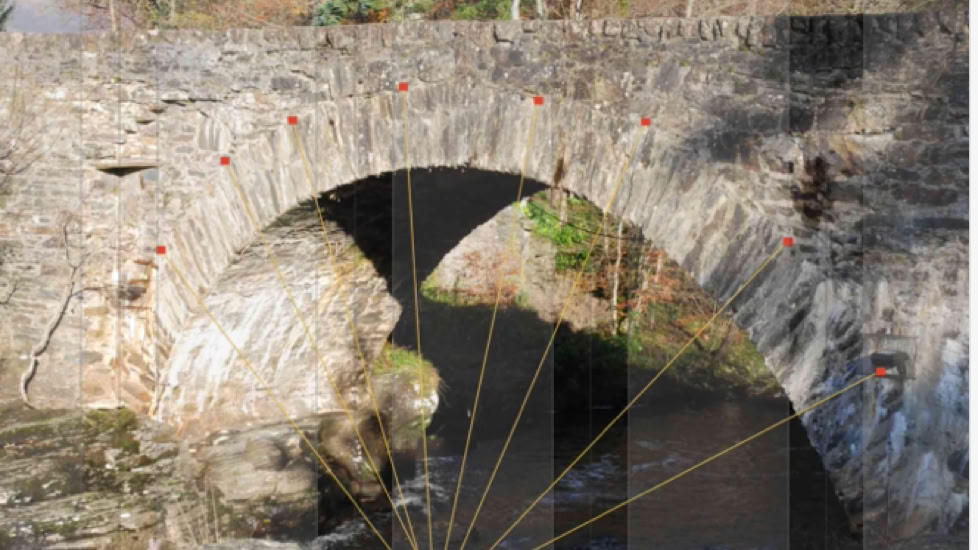
To be differentiated from -
The above military bridges, as a group, have to be differentiated from the parliamentary bridges which arrived after 1803 and are not in this catalogue. The Commission for Highland Roads and Bridges was established by an act of Parliament, and Thomas Telford was the chief engineer. He set out very firm specifications for different types of parliamentary bridge. The minimum specification was 12ft wide but very few were so narrow. There were four main styles. Types 1 to 3 were rubble-built but in much better-dressed stone than is found on military bridges. The voussoirs were of quality dressed stone, sometimes ashlar. Type 1 was gently humped, but levelled deckings were generally typical of types 2 and 3. All had outward sloping (battered) spandrels or abutments; this is their most salient characteristic. On type 3 bridges each abutment was stepped into a greater outward slope, while the spandrels were plumb; the vertical step ran from parapet to springing. This might be called the 'plumb and batter' build. The type 4 Parliamentary bridges cannot be confused with the older military bridges because they are very much larger, ashlar-built and multi-arched, with cutwaters merging into the refuges; their large segmental arches were in beautifully dressed stone with recessed voussoirs. The spandrels, approaches and abutments were in coursed, dressed, squared rubble. Good examples are at Dunkeld, Potarch, Dunans and Invermoriston. In 1829 Telford recorded that 1117 bridges had been built by the Highlands Commission.

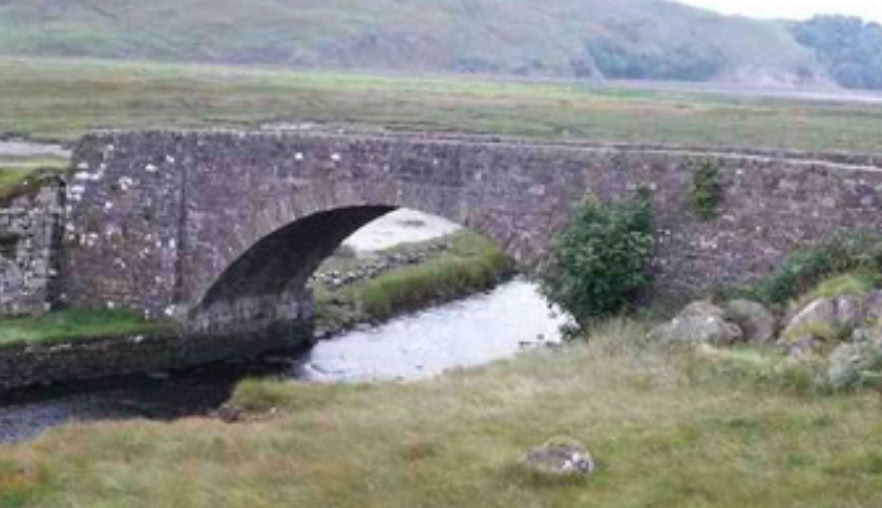
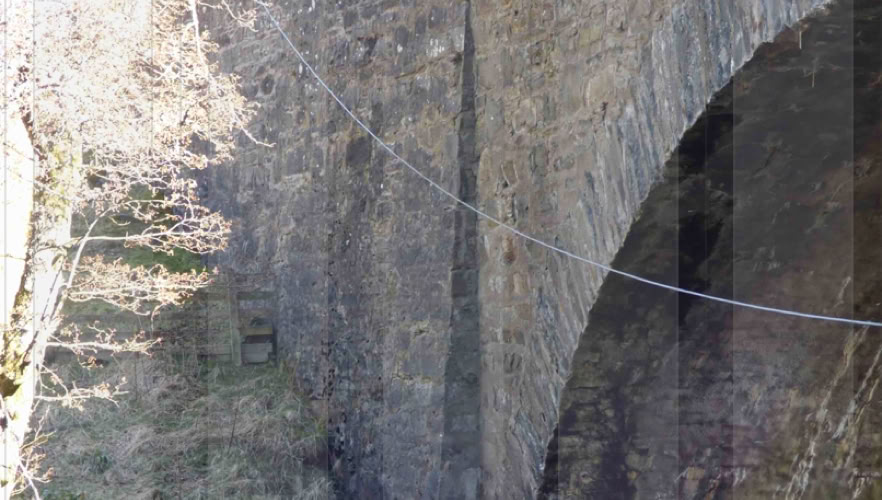

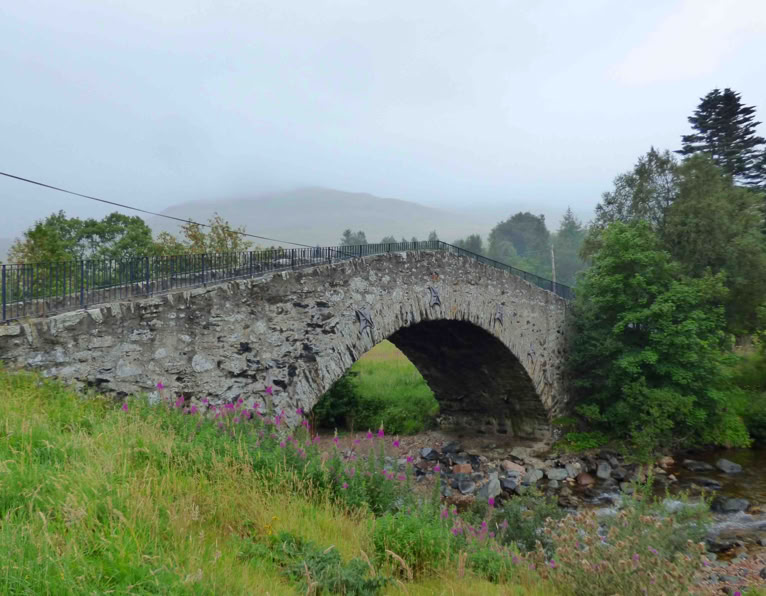
18th C. Military Bridges
The 18thcentury Highland military roads provide us with a separate group with interesting features. General Wade built 250 miles of road and 40 bridges between 1725 and 1734, of which 17 remain and are present in this catalogue (Fig. Garbhamor). Many of Wade’s bridges were contracted out rather than army built. There are recorded invoices for 35 bridges of which 30 had a single arch. Major Caulfeild built many more roads and bridges than Wade, but he started in 1741, and only a little of his work was completed when the Roy survey was done. Two Caulfield roads were finished by the time of Roy’s survey, and two more were being built during it. This is a small proportion of the 17 roads that are firmly attributed to the Major. The final tally, by 1780, amounted to some 800 military bridges, so only a tiny proportion of the oldest are shown in the catalogue, and the huge majority have long gone. However, there are 11 existing Caulfeild bridges, identifiable on Roy, and these are catalogued. Several more are in the catalogue because the bridge had a predecessor on the map.
The military bridges are of un-coursed, random rubble, cheaper and faster to make, thus suiting a military need; the arches are flush, not recessed; spandrels are plain and vertical which is an important difference from Telford Parliamentary bridges; they seldom have a string course; if built over a ravine, they have a horizontal deck, otherwise they are usually more pointed than humped, and have sloping parapets up to the crown; the arches are also of rubble, often whinstone.
To differentiate more particularly, Wade arches are more often semicircular with with the arch-focus above the water-line, whereas Caulfeild's bridges all have segmental arches. Wade arches have unaligned voussoirs of equal length; Caulfield voussoirs are aligned and of random uneven length. Wades bridges are 8 to 11 ft. wide, from parapet to parapet. Caulfeild's are 12 ft wide.
Caulfeild bridges are of a higher standard of masonry, more elegant, and often have an interesting texture of uncoursed large boulders with smaller stones (gallets) in between. Fig. Spittal of Glenshee Bridge, Caulfeild from 1749.
These bridges were impressive works of civil engineering that have stood the test of time. Yet, Taylor (Ref), in his definitive ‘Military Roads of Scotland’, refers to something more: “Although considerations of natural beauty were far from the minds of the military road makers …...The bridges over Tay, Tummel, Garry, Spey at Garbhamor, Spean and Findhorn at Dulsie, have a romantic grace and beauty which almost belie their usefulness and efficiency.”
An expandable map of all the military roads can be found here.
Lowland Commission of Supply bridges (18th and also early 19th century) have a similar style. Much of the bridgework in the South was repair and maintenance. However, there were quite a few new-builds. Good examples can be seen at Barskimming, Coyle, Barr and Ricarton: large, wide segmental arches with ashlar, recessed voussoirs and coursed rubble spandrels and approaches. At Ricarton, south of Kilmarnock, the spandrels are in ashlar. These bridges had much in common with the Telford styles, and at Barr (Fig) a plumb and batter can be seen to the right-hand side. In general, the quality of stone used for voussoirs and abutments improved from 1750 onwards with recessed ashlar arches becoming steadily more common.
In general, 19th century builds had an improved quality of stonework. At first, ashlar became common for the voussoirs, but later it became routine for the entire structure. The masonry became more decorative and well finished often with balustraded parapets. Low segmental or elliptical arches arrived, and these were usually stilted on well-finished piers.
Heraldry and date inscriptions.
Heraldry and inscription are important, but a great deal caution is required; frequently the heraldic carving was retained through thick and thin even being transferred to entirely new builds, or moved from one side of the bridge to the other when rebuilding or widening was taking place. Date-stones should always be viewed with suspicion; more often than not they refer to a repair date. Throughout history, it seems it was quite routine to include a date plaque at the time of any major repair or restructuring. This can be very misleading.
Dating.
Finally, it has to be admitted that attributing a date to an ancient structure has always been an inexact science. The style of the stonework, the shape and span of the arches, the size of the piers, the width of the decking and many other elements, not least the general condition, are all important. The overall profile, which is even less definable, may be a very significant part of any assessment. All these features have to be balanced against the historical data which is often very limited in both scope and authenticity. There is room for uncertainty, and there are many enigmas.
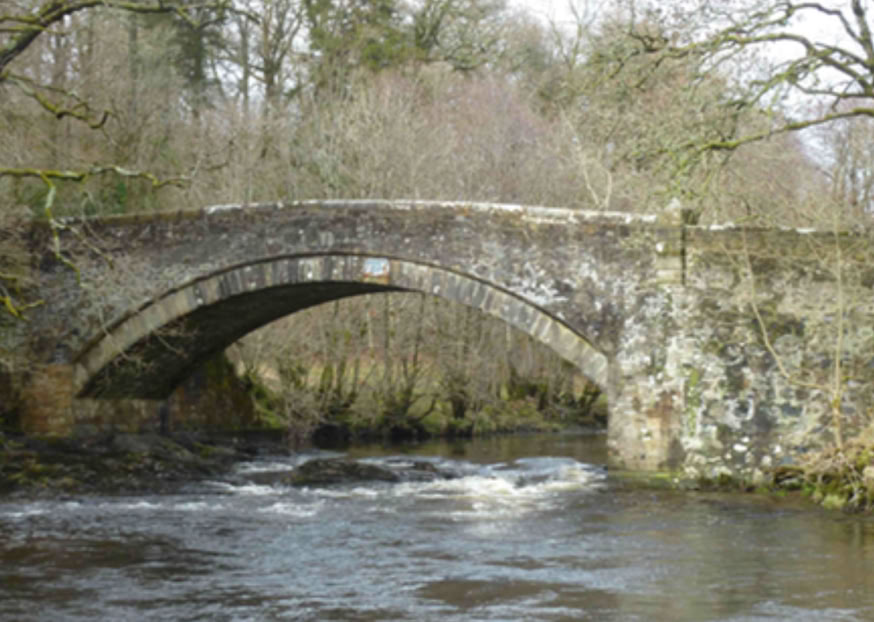
Page last updated Oct ‘24